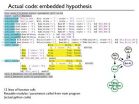(Press-News.org) BALTIMORE – February 19, 2014. Adding bevacizumab (Avastin) to standard chemotherapy and radiation treatment does not improve survival for patients newly diagnosed with the often deadly brain cancer glioblastoma, researchers report in the Feb. 20 issue of the New England Journal of Medicine.
"We didn't see an improvement in overall survival or a statistically significant increase in progression-free survival, as defined in the context of this trial," says the study's senior author, Minesh P. Mehta, M.B., Ch.B., Professor of Radiation Oncology at the University of Maryland School of Medicine and a radiation oncologist at the University of Maryland Marlene and Stewart Greenebaum Cancer Center.
The U.S. Food and Drug Administration (FDA) has approved the use of bevacizumab to treat recurrent glioblastoma. Researchers sought to learn whether the drug could be beneficial as a first-line treatment.
The Phase III clinical trial, conducted by the Radiation Therapy Oncology Group (RTOG), randomized 637 patients at multiple centers, including the University of Maryland Greenebaum Cancer Center, into two groups.
Patients who received the standard treatment, plus a placebo, had a median survival of 16.1 months compared to 15.7 months for those who received the standard treatment plus bevacizumab. Although it took slightly longer for the cancer to progress in patients receiving bevacizumab (10.7 months vs. 7.3 months), the rate of progression-free survival did not meet pre-specified criteria to be statistically meaningful, according to Dr. Mehta.
Dr. Mehta, who chairs the RTOG's brain tumor committee, says researchers also found an increase in symptoms among patients who took bevacizumab, compared to a placebo. "We observed higher rates of neurocognitive decline, increased symptom burden and a decline in health-related quality of life over time among non-progressing patients treated with bevacizumab," he says. Bevacizumab's side effects include vascular problems such as hypertension, protein in urine and bleeding.
Dr. Mehta says the cognitive decline may have stemmed from unrecognized progression of the cancer, masked by the use of bevacizumab, or neurotoxicity related to the bevacizumab.
Glioblastoma is the most common and deadliest of malignant primary brain tumors in adults. It strikes two to three out of 100,000 people every year in the United States and Europe. Standard treatment is surgery, followed by radiation therapy and chemotherapy with temozolomide. Even with treatment, the average survival is approximately only 16 months. Few patients survive beyond five years. This cancer is characterized by the growth of new blood vessels, known as angiogenesis. Bevacizumab, a monoclonal antibody, is an angiogenesis inhibitor that targets a chemical signal, vascular endothelial growth factor A (VEGF-A).
The study, which was led by principal investigator Mark Gilbert, M.D., a neuro-oncologist at The University of Texas M.D. Anderson Cancer Center, was sponsored by the National Cancer Institute (NCI) (U10 CA21661 and U10 CA37422). Genentech provided additional support through an educational grant.
E. Albert Reece, M.D., Ph.D., M.B.A., vice president for medical affairs at the University of Maryland and the John Z. and Akiko K. Bowers Distinguished Professor and dean of the University of Maryland School of Medicine, says, "Although researchers found that bevacizumab did not improve survival for patients newly diagnosed with glioblastoma, large-scale clinical studies such as this provide scientists with very valuable information and lay the groundwork for future research. Patients with glioblastoma have very few treatment options, and we need to continue our search for new ways to attack this very aggressive cancer."
Dr. Mehta notes that angiogenesis inhibitors, such as bevacizumab, have shown great promise in the treatment of cancer, but this study offers some perspective. "Anti-angiogenic agents are not going to be a cure-all for every cancer. They will probably have a role in several malignancies but not necessarily every one," he says.
Results of this study were reported in part at the annual meeting of the American Society of Clinical Oncology (ASCO) in Chicago in June 2013.
INFORMATION:
About the University of Maryland School of Medicine
Established in 1807, the University of Maryland School of Medicine is the first public medical school in the United States, and the first to institute a residency-training program. The School of Medicine was the founding school of the University of Maryland and today is an integral part of the 11-campus University System of Maryland. On the University of Maryland's Baltimore campus, the School of Medicine serves as the anchor for a large academic health center which aims to provide the best medical education, conduct the most innovative biomedical research and provide the best patient care and community service to Maryland and beyond. http://www.medschool.umaryland.edu.
About the University of Marlene and Stewart Greenebaum Cancer Center
The University of Maryland Marlene and Stewart Greenebaum Cancer Center, a National Cancer Institute-designated center in Baltimore affiliated with the University of Maryland Medical Center and University of Maryland School of Medicine, offers a multidisciplinary approach to treating all types of cancer and has an active cancer research program. It is ranked in the top 50 cancer programs in the nation by U.S. News & World Report. For more information, go to http://www.umgcc.org.
Bevacizumab (Avastin) fails to improve survival for newly diagnosed glioblastoma patients
University of Maryland School of Medicine radiation oncologist is senior author of brain cancer study
2014-02-20
ELSE PRESS RELEASES FROM THIS DATE:
SDSC team develops multi-scale simulation software for chemistry research
2014-02-20
Researchers at the San Diego Supercomputer Center at the University of California, San Diego, have developed software that greatly expands the types of multi-scale QM/MM (mixed quantum and molecular mechanical) simulations of complex chemical systems that scientists can use to design new drugs, better chemicals, or improved enzymes for biofuels production.
A paper outlining the research, titled 'An Extensible Interface for QM/MM Molecular Dynamics Simulations with AMBER' and conducted by members of the Walker Molecular Dynamics Lab (WMD) at SDSC, was featured on the cover ...
Clutter cutter
2014-02-19
WASHINGTON D.C. Feb. 19, 2014 -- Life can be messy at all scales, requiring different organizational strategies -- from cleaning the house, to removing damaged or expired cells from the body to avoid cancer progression.
In a messy house, people use computers to manage paper and photo clutter; companies use computer systems to track their inventory. Now a team of researchers at Vanderbilt University in Nashville, Tenn., is taking a similar approach to cell-molecular inventory control for cancer. They have created computer models, using their programming framework (PySB), ...
Does more stress equal more headaches?
2014-02-19
PHILADELPHIA – A new study provides evidence for what many people who experience headache have long suspected—having more stress in your life leads to more headaches. The study released today will be presented at the American Academy of Neurology's 66th Annual Meeting in Philadelphia, April 26 to May 3, 2014.
For the study, 5,159 people age 21 to 71 in the general population were surveyed about their stress levels and headaches four times a year for two years. Participants stated how many headaches they had per month and rated their stress level on a scale of zero to ...
Insurance status may influence transfer decisions in trauma cases, Stanford study reveals
2014-02-19
STANFORD, Calif. — Emergency rooms are less likely to transfer critically injured patients to trauma centers if they have health insurance, according to a new study by researchers at the Stanford University School of Medicine.
The counterintuitive finding suggests that insured patients are more at risk for receiving sub-optimal trauma care than uninsured patients are.
Although a majority of severely injured trauma patients are initially taken to trauma centers, at least one-third are taken to non-trauma centers. In these cases, emergency room doctors must assess the ...
HPV vaccination is associated with reduced risk of cervical lesions in Denmark
2014-02-19
A reduced risk of cervical lesions among Danish girls and women at the population level is associated with use of a quadrivalent HPV vaccine after only six years, according to a new study published February 19 in the Journal of the National Cancer Institute.
Two HPV vaccines are currently available and have proven to be highly effective against HPV16/18-associated cervical cancer. One of these vaccines, a quadrivalent vaccine, was licensed in Denmark in 2006, and it was subsequently incorporated into general childhood vaccination programs for girls free of charge and ...
Whole genome analysis, stat
2014-02-19
Although the time and cost of sequencing an entire human genome has plummeted, analyzing the resulting three billion base pairs of genetic information from a single genome can take many months.
In the journal Bioinformatics, however, a University of Chicago-based team—working with Beagle, one of the world's fastest supercomputers devoted to life sciences—reports that genome analysis can be radically accelerated. This computer, based at Argonne National Laboratory, is able to analyze 240 full genomes in about two days.
"This is a resource that can change patient management ...
Study shows in vivo endomicroscopy improves detection of Barrett's esophagus-related neoplasia
2014-02-19
DOWNERS GROVE, Ill. – February 19, 2014 – New research shows that the addition of confocal laser endomicroscopy to high-definition white-light endoscopy enables improved real-time endoscopic diagnosis of Barrett's esophagus dysplasia (neoplastic tissue) by using targeted biopsies of abnormal mucosa to reduce unnecessary mucosal biopsies and potentially reduce costs. It may also positively influence patient care by changing the plan for immediate endoscopic management. The study appears in the February issue of GIE: Gastrointestinal Endoscopy, the monthly peer-reviewed scientific ...
RXTE reveals the cloudy cores of active galaxies
2014-02-19
VIDEO:
Zoom into the cloudy heart of an active galaxy. This animation shows an artist's rendition of the cloudy structure revealed by a study of data from NASA's Rossi X-Ray Timing...
Click here for more information.
Picture a single cloud large enough to span the solar system from the sun to beyond Pluto's orbit. Now imagine many such clouds orbiting in a vast ring at the heart of a distant galaxy, occasionally dimming the X-ray light produced by the galaxy's monster black ...
NuSTAR helps untangle how stars explode
2014-02-19
For the first time, an international team of astrophysicists, including Lawrence Livermore National Laboratory scientists, have unraveled how stars blow up in supernova explosions.
Using NASA's Nuclear Spectroscopic Telescope Array (NuSTAR) – a high-energy X-ray observatory - the international collaboration created the first-ever map of radioactive material in a supernova remnant, named Cassiopeia A, or Cas A for short. The findings reveal how shock waves likely rip apart massive dying stars, and ultimately end their lives.
A supernova is the cataclysmic death of a ...
REACT clinical trial supports new approach of accelerated treatment for Crohn's disease
2014-02-19
The final results from an international clinical trial involving nearly 2,000 patients with Crohn's disease support the use of a new management strategy referred to as accelerated step-care as a best practice for the care of active Crohn's disease. The REACT (Randomized Evaluation of an Algorithm for Crohn's Treatment) study, led by Robarts Clinical Trials at Western University (London, Canada) provides valuable new insights for community gastroenterologists which should benefit patients. The results of the study will be presented at the European Crohn's and Colitis Organisation ...
LAST 30 PRESS RELEASES:
Injectable breast ‘implant’ offers alternative to traditional surgeries
Neuroscientists devise formulas to measure multilingualism
New prostate cancer trial seeks to reduce toxicity without sacrificing efficacy
Geometry shapes life
A CRISPR screen reveals many previously unrecognized genes required for brain development and a new neurodevelopmental disorder
Hot flush treatment has anti-breast cancer activity, study finds
Securing AI systems against growing cybersecurity threats
Longest observation of an active solar region
Why nail-biting, procrastination and other self-sabotaging behaviors are rooted in survival instincts
Regional variations in mechanical properties of porcine leptomeninges
Artificial empathy in therapy and healthcare: advancements in interpersonal interaction technologies
Why some brains switch gears more efficiently than others
UVA’s Jundong Li wins ICDM’S 2025 Tao Li Award for data mining, machine learning
UVA’s low-power, high-performance computer power player Mircea Stan earns National Academy of Inventors fellowship
Not playing by the rules: USU researcher explores filamentous algae dynamics in rivers
Do our body clocks influence our risk of dementia?
Anthropologists offer new evidence of bipedalism in long-debated fossil discovery
Safer receipt paper from wood
Dosage-sensitive genes suggest no whole-genome duplications in ancestral angiosperm
First ancient human herpesvirus genomes document their deep history with humans
Why Some Bacteria Survive Antibiotics and How to Stop Them - New study reveals that bacteria can survive antibiotic treatment through two fundamentally different “shutdown modes”
UCLA study links scar healing to dangerous placenta condition
CHANGE-seq-BE finds off-target changes in the genome from base editors
The Journal of Nuclear Medicine Ahead-of-Print Tip Sheet: January 2, 2026
Delayed or absent first dose of measles, mumps, and rubella vaccination
Trends in US preterm birth rates by household income and race and ethnicity
Study identifies potential biomarker linked to progression and brain inflammation in multiple sclerosis
Many mothers in Norway do not show up for postnatal check-ups
Researchers want to find out why quick clay is so unstable
Superradiant spins show teamwork at the quantum scale
[Press-News.org] Bevacizumab (Avastin) fails to improve survival for newly diagnosed glioblastoma patientsUniversity of Maryland School of Medicine radiation oncologist is senior author of brain cancer study



